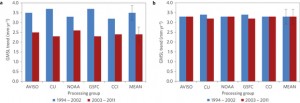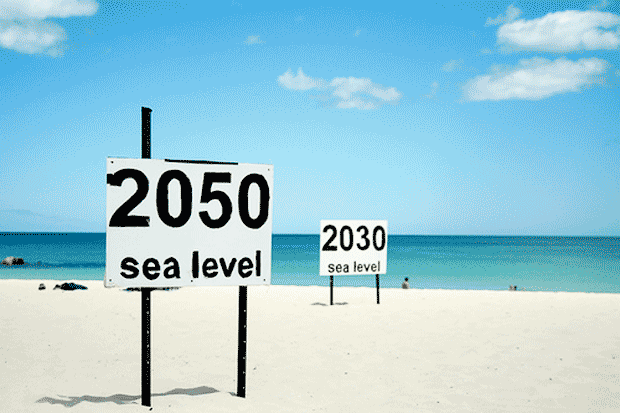Study on the Rate of Sea-Level Rise (2014)
The most prominent signature in the global mean sea level interannual variability is caused by El Niño–Southern Oscillation, through its impact on the global water cycle.
A new study paper out in nature (Nature Climate Change / 2014 / doi:10.1038/nclimate2159), explores why the rise of sea-level has slowed in the last decade.
This slow-down coincidences with the observed climate hiatus (IPCC AR5, Ocean heat content uptake). Because heat is distributed differently, depending on the state of ENSO (between El Nino or La Nina).

Abstract: Present-day sea-level rise is a major indicator of climate change1. Since the early 1990s, sea level rose at a mean rate of ~3.1 mm yr−1 (refs 2, 3). However, over the last decade a slowdown of this rate, of about 30%, has been recorded4, 5, 6, 7, 8. It coincides with a plateau in Earth’s mean surface temperature evolution, known as the recent pause in warming1, 9, 10, 11, 12. Here we present an analysis based on sea-level data from the altimetry record of the past ~20 years that separates interannual natural variability in sea level from the longer-term change probably related to anthropogenic global warming. The most prominent signature in the global mean sea level interannual variability is caused by El Niño–Southern Oscillation, through its impact on the global water cycle13, 14, 15, 16. We find that when correcting for interannual variability, the past decade’s slowdown of the global mean sea level disappears, leading to a similar rate of sea-level rise (of 3.3 ± 0.4 mm yr−1) during the first and second decade of the altimetry era. Our results confirm the need for quantifying and further removing from the climate records the short-term natural climate variability if one wants to extract the global warming signal10.
However, last year a study hinted at significant future sea-level rise – In Ancient Ice, Clues That Scientists Are Underestimating Future Sea Levels
Related
- RealClimate: It Never Rains but it Pause
- RealClimate: Global Temperature 2013
- Slower sea level rise linked to El Nino and natural weather patterns
- Cutting Short-lived Pollutants Can Slow Sea Level Rise
- Australia’s Flooding Rains Briefly Slowed Sea Level Rise
Teaser image via Ocean Defender
